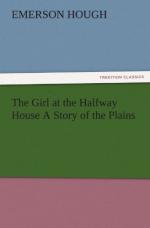It was upon one day that Mother Daly looked out upon her world; upon the next day she looked again, and all the world was changed. Far as the eye could reach, the long and dusty roadway of the cows lay silent, with its dust unstirred. Far, very far off, there was approaching a little band of strange, small, bleating, woolly creatures, to whose driver Mother Daly refused bed and board. The cattle chutes were silent, the corral was empty. At the Cottage bar the keeper had at last found a key to the door. Up and down the Trail, east and west of the Trail, all was quiet, bare, and desolate. At some signal—some signal written on the sky—all the old life of Ellisville had taken up its journey into a farther land, into another day. The cowman, the railroad man, and the gambling man had gone, leaving behind them the wide and well-perforated Cottage, the graveyard with its double street, the cattle chutes with well-worn, hairy walls.
Now there came upon the face of the country faint scars where wheels had cut into the hard soil, these vagrant indices of travel not pointing all one way, and not cut deep, as was the royal highway of the cattle, but crossing, tangling, sometimes blending into main-travelled roads, though more often straying aimlessly off over the prairie to end at the homestead of some farmer. The smokes arose more numerously over the country, and the low houses of the settlers were seen here and there on either hand by those who drove out over the winding wagon ways in search of land. These new houses were dark and low and brown, with the exception that each few miles the traveller might see a small frame house painted white. Sometimes, in the early morning, there might be seen wandering toward these small white houses, no man knew whence, small groups of little beings never before seen upon the range. At nightfall they wandered back again. Sometimes, though rarely, they needed to turn aside from the straight line to go about the corner of a fence. Sometimes within such fences there might be seen others of these dirty, bleating creatures which Mother Daly hated. Here and there over the country were broken rows of little yellow, faded trees struggling up out of the hard earth. The untiring wheels of windmills could be seen everywhere at their work.
Here and there at the trodden, water holes of the broken creeks there lay carcasses of perished cattle, the skin dried and drawn tight over the bones; but on the hillsides near by grazed living cattle, fatter and more content to feed than the wild creatures that yesterday clacked and crowded up the Trail. Now, it is known of all men that cattle have wide horns, broad as the span of a man’s arms; yet there were men here who said they had seen cattle whose horns were no longer than those of the buffalo, and later this thing was proved to be true.
Mother Daly knew, as all persons in the past knew, that by right the face of the plains was of one colour, unbroken; gray-brown in summer, white in winter, green in the spring. Yet now, as though giants would play here some game of draughts, there came a change upon the country, so that in squares it was gray, in squares green. This thing had never been before.




